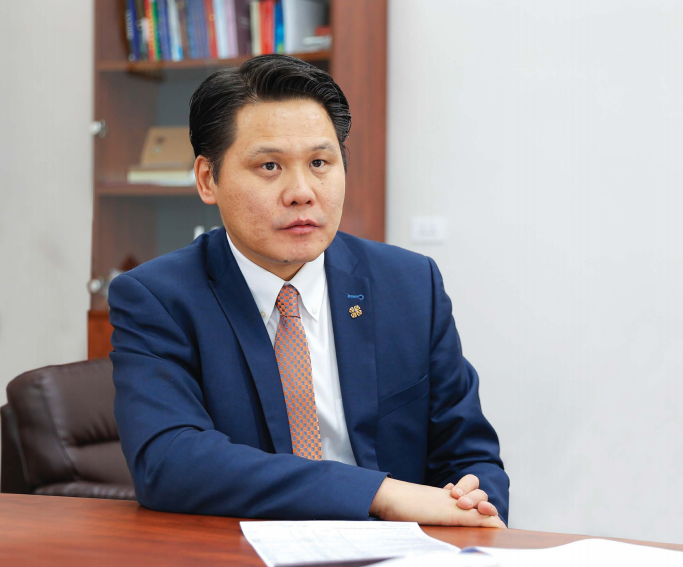 Odjargal. E from Mining Insight interviewed Tulga. B, Minister, and Chairman of the National Committee for Port Revitalization.
Odjargal. E from Mining Insight interviewed Tulga. B, Minister, and Chairman of the National Committee for Port Revitalization.
What is the current capacity of Mongolia's dry ports?
Mongolia currently holds the 130th position out of 160 countries in port capacity. Acknowledging this, it is noteworthy that in the World Bank's Transport and Logistics Performance Index report, Mongolia ranks 97th with 2.5 points among 139 countries. The existing limitations in port capacity, infrastructure, and national logistics significantly impede our country's foreign trade and economic development. As a response, the Government's New Recovery Policy has identified "Port Recovery" as a central goal to stimulate and broaden economic growth.
How do you foresee the execution of the "Port Recovery" initiative?
Over the past 30 years since the 1990s, Bayannuur province has been setting the price of coal rather than relying on the Chinese market, which is a vital income source for Mongolia due to its limited export products. To enhance competitiveness, supplying Tavantolgoi coal through multiple ports can raise prices. Unlike Australia, a key player in the market that plans its annual coal supply, Mongolia has witnessed rapid growth in coal exports to China this year, partly due to China lifting its unofficial ban on Australian coal. However, Australia's exports to China remained modest as it wasn't part of Australia's annual planning. During the Australian Prime Minister's visit to China on November 6, 2023, agreements were signed with 250 mining companies, signaling strong competition in China's coal market next year. This development might impact Mongolia's target of exporting 60 million tonnes of coal in 2024. I advocate for establishing a trade ministry to negotiate and pre-calculate supply amounts with importing countries. The current state of ports reflects a lack of research, clarity, and strategic planning. Therefore, to align with market trends and demand, the "Port Recovery" policy will be implemented in collaboration with neighboring countries' port planning. A port is more than a point of entry and exit; referring to it as a mere gateway is inaccurate. In contemporary times, many of our dry ports lack literal gateways, adopting instead an open, accessible concept. Consequently, initial planning focuses on specific aspects of the ports. This encompasses entrance structures, customs control zones, parking facilities, passenger lounges, and offices for customs officials. Subsequent phases involve the development of port cities, tourism facilities, free zones, and industrial parks. Implementing well-coordinated deep ports in a staged manner will enhance the competitive edge of our country's transportation and logistics.
How do you interpret the economic and trade dynamics with China, which stands as Mongolia's foremost foreign trade partner and primary export market?
In the expansive Chinese market, a defining force in the global economy, nations vie to provide their goods and compete. From the standpoint of international geopolitics, domestic considerations, and amicable relations with neighboring nations, China expresses interest in enhancing trade ties with Mongolia. Considering China's vast population and diverse regions, there exist approximately 400 "countries," each akin to Mongolia, boasting its distinct market. To illustrate, a village with a population of 3 million in our country may specialize in a singular product, distributing it to other regions within the nation. Essentially, within China, 400 "markets" engage in trade with one another. Mongolia is intricately connected with such an extensive trading network. By comprehensively studying and understanding the markets of these regions, we unlock opportunities to broaden our trade horizons. While Mongolia may not engage in trade with over 200 countries, it holds the advantage of collaborating in 400 distinct "markets" along its borders. Therefore, this year's coal export emphasizes that trade is not solely dependent on port infrastructure.
However, there is an anticipation that our country's exports and trade will experience a substantial boost through the interconnection of port railways, correct?
Presently, the port railway plays a crucial role in facilitating the cost-effective export of mining products and bulk cargo, particularly coal, which constitutes a significant portion of our country's exports. Looking ahead, the port's capacity becomes pivotal not only for the continued growth of the mining sector but also for the development of agriculture, other export products, industry, and tourism. The Chinese perspective aligns with this strategic calculation. For instance, considerations arise regarding the nature and volume of cargo originating from Dornod, Khentii province, Ulaanbaatar, and Russia, destined for transport
through the Zuunkhatavch port and export to the Chinese market. The Chinese counterparts seek estimations on cargo size, potential development, and the range of products to be exported through the interconnection of the four ports by rail. In the future, the three neighboring countries aim to bolster their trade relationships, fostering port development through open discussions on port planning, the economic potential of border regions, transport logistics, and infrastructure, as opposed to keeping information from one another.
Do the four ports that will be connected to railways featured in China's 14th five-year plan?
The current plan in China references "4 ports+1," encompassing Zuunkhatavch, Ereen, Mandal, Gantsmod, and Ulzii ports. The railway connection from Bichigt-Zuunkhatavch port aligns with the developmental objectives of the country's eastern region. Logistics are underway to facilitate the transportation of goods from Zuunkhatavch port, situated in the Xilingol League of Inner Mongolia, to the east coast of the sea. A railway has been constructed from Baotou to Mandal Port, part of the Darhan Muminggan United Banner of Inner Mongolia. Once the Khangi-Mandal port railway is established, it will provide direct access for the primary consumers of Mongolian coking coal in China to factories in the Baotou metallurgical cluster, Wuhai province, and further regions such as Gansu, Hebei, Shanxi, and Ningsha provinces. Presently, Tavantolgoi coal is imported through Gantsmod port, transported to Bayannuur province, and then reaches the final consumers. There is an interest in importing Tavantolgoi and Nariinsukhait coal through Ulzii Port, belonging to Alshaa Province. However, each region has its own economic policies and faces specific competition. Consequently, decisions regarding railway ports on the Mongolian side, connecting Umnugovi, Dornogovi, and Dornod provinces, will be made by the central government of China, rather than the border regions. This complexity contributes to delays in the railway connection of the ports. Due to China prioritizing its eastern ports and the limited infrastructure in Mongolia and the western region of Russia, the ports on this side are not currently factored into calculations. Ceke port is considered local by the Chinese central government. Following the construction of the railway in the Artssuuri-Shiveekhuren direction, there is a national vision to include western ports, including the Ceke port. However, the lack of infrastructure on the Russian side beyond the port of Artssuuri means it may take 5-10 years to establish railway infrastructure in the western regions of Mongolia and Russia. Consequently, the Chinese side is presently focused on the western ports.
What about Mongolia?
Negotiations between the Mongolian and Chinese sides take the form of a "1+3+1 port" framework. In addition to the Zamyn-Uud, Bichigt, Gashuunsukhait, Shiveekhuren, and Khangi ports, initially included in the 1955 agreement, will be linked by rail in 2014. An agreement has been reached to establish the Khangi-Mandal port railway connection. Furthermore, a joint understanding with the Chinese side has been achieved concerning the Gashuunsukhait-Gantsmod port railway connection. Three Working Groups, responsible for legal aspects, economic assessments, and engineering solutions, have been established and are convening regularly. While the railway has been extended to Gashuunsukhait port, the border crossing point remains distant. To facilitate the connection, it is imperative to construct intricate bridge structures employing engineering solutions. The commencement of cross-port railway construction is planned for the upcoming spring, with the goal of operationalizing it within the year. Starting in 2025, direct railway transportation through Gashuunsukhait-Gantsmod port will be established. This railway construction will subsequently link with the Khangi-Mandal port railway. Initially, the Chinese stance positioned Mandal's decision after Gantsmod and Zuunkhatavch port railways. However, due to persistent requests from the Mongolian side, particularly from government officials, the possibility is there for establishing the Gashuunsukhait-Gantsmod port railway connection.
Is the delay in the Khangi and Shiveekhuren railway connection attributed to challenges related to matching points?
An agreement has been reached with the Chinese side to interconnect these railways across the border of both countries. During the visit of the President of Mongolia to China on October 18, 2023, an agreement was signed for the Shiveekhuren-Ceke port railway. A 10km wide and narrow gauge railway will traverse the ports of both countries. Currently, a 7-kilometer railway, funded by private investment, is under construction to connect Shiveekhuren and Ceke port, with completion expected by year-end. Once this railway is established, cargo can be transported by trains, offering an annual capacity of 20 milli
on tonnes, comparable to the current capacity of the Gashuunsukhait-Gantsmod port. The Shiveehuren-Seke port railway is anticipated to commence operations next year. Adjacent to the Ceke port, there is a railway connecting Asia and Europe at a distance of 3.4 km. The Chinese side is engaged in calculations and designs for the railway leading to the port, a project recently endorsed by the country's Development and Reform Commission. Completion is anticipated by August next year.
Is there investor interest in the 1255 km railway project along the western vertical axis from Artssuuri to Shiveekhuren? This project surpasses the combined length of all newly constructed railways in Mongolia over the past three years.
Investors are hesitant to engage primarily due to the absence of a well-defined economic assessment aligning with the prospective development of the western region of Mongolia along the railway route. They perceive a risk of it becoming a "dead asset." The “revitalization” of domestic businesses is contingent on the concurrent development of our ports. Foreign investors require thorough economic calculations before committing. Hence, the initiation of numerous projects hinges on the modernization and capacity expansion of the ports.
What is the current status of the Bichigt port?
The Chinese side has proposed commencing the construction of the cross-port narrow-gauge railway within the fourth quarter of this year. Funded by the Asian Development Bank, the expansion of Bichigt port began in July and is anticipated to conclude by the end of the coming year. If the feasibility study and design work for the project to upgrade the 238 km railway line in the Ereentsav-Bayantumen direction commence this year, the plan is to have it operational within the next two years. Additionally, the technical design for the 192 km Choibalsan-Khuut route and the 234 km KhuutBichigt railway project is underway through a publicprivate partnership. The alignment of interests among the three countries becomes evident with the planned opening of the transit corridor through the BichgtZuunkhatavch port.
As the Minister of Ports, what is your primary focus?
Within the framework of Mongolia's long-term development policy, "Vision-2050," and the initiative "Port Recovery," the National Committee for Port Recovery is dedicated to advancing both hard and soft infrastructure for the efficient passage of passenger and cargo vehicles. The primary objective is to enhance capacity, ultimately boosting export capabilities. Our current focus is directed towards formulating the master plans for Bichigt, Khangi, and Gashuunsukhait ports. If the approval for a USD 4 million grant materializes, an international tender will be announced this year, with the intention of developing the port into a fully functional city. Collaboration with internationally experienced companies, particularly those with a track record in planning Chinese ports, is under consideration. Land allocation at the port is not expected to pose an issue. Once the master plan is finalized, all projects within the port will be determined. Private sectors will then invest in projects aligned with their interests, overseeing the construction and operation of their businesses. The integrated system outlined in the port's master plan includes aspects such as electrical supply, water consumption, loading and unloading areas, parking lots, restaurants, and hotels. This approach avoids situations where land is provided without comprehensive planning, preventing the emergence of isolated facilities like coal unloading areas or canteens. In Gashuunsukhait port, for example, there is currently nothing beyond electricity and water, emphasizing the need for strategic planning that considers infrastructure on both sides of the border. Furthermore, our country aims to transition towards managing ports through public-private partnerships, providing increased support to the private sector. Drawing on successful experiences like "Chinggis Khaan" International Airport, established with Japanese investment, which operates under a 15- 20-year contract, highlights the effectiveness of such partnerships. Ongoing efforts include the construction of multi-modal transport terminals through public-private collaborations, such as the container terminal opened by three mining companies at Gashuunsukhait port during the pandemic. The container terminal at Shiveekhuren port is ready for inauguration, and the construction of a multi-modal transport terminal at Khangi Port is slated for completion this year. To establish a supportive legal framework for such collaborations, discussions are underway for the approval of the Law on Ports during the spring session of the Parliament.
What potential solutions are being considered for managing Mongolia's cargo traffic at Tianjin port?
People often express the idea of effortlessly unloading containers on 10 hectares of Mongolian land at Tianjin port and transporting them here. However, the reality differs significantly. When a convoy of trains arrives in Ulaanbaatar, there is currently insufficient technical, infrastructural, and logistical capacity to disperse and unload 50 wagons within a single day. To address this challenge, collaborative efforts with the private sector within the "Port Recovery" initiative can focus on constructing dry ports, cargo transportation logistics terminals, and centralized urban centers.
Following challenging negotiations with the Chinese side, Zamyn-Uud port is now the first in Mongolia to operate 24 hours a day. Is that correct?
The Mongolian side's request, pending since 1992, has now seen successful negotiations, leading to an agreement. Commencing from December 1st, the Zamyn-Uud port will undergo a trial operation, operating 24 hours a day. Following that, Ereen will become the second continuously operating port among the 315 ports in China. The trial operation is expected to last 1-2 years, and personally, I have confidence in its effectiveness. The Ministry of Road and Transport Development has revealed two concessions for constructing a 4-lane road connecting Zamyn-Uud and Altanbulag port. The completion of this project holds significance in reducing railway traffic in the central corridor and bolstering road transit. By developing infrastructure in this manner, our country's income is poised to increase through commercial transit with Russia and China.
The trade turnover between Russia and China has surged to USD 200 billion. Has there been a study on the potential trade volume involving neighboring countries that Mongolia could facilitate through its territory?
Currently, there is no definitive study available. The precise estimate of trade conducted by neighboring countries through Mongolia's territory remains challenging due to ongoing infrastructure developments. Construction of roads and railways, modernization of ports, and the need to enhance the capacity of the central corridor railway contribute to the complexity of making accurate projections. Neighboring countries express interest in engaging in trade through Mongolia's local short-term transit. The future connection of the new 4 ports by rail is expected to facilitate transit through all of them. This transit will involve entering China via two railways from the Russian side, passing through Mongolia, and entering China through five railways. A recent completion of construction between Tsagaanuur and Bulgan ports has significantly increased Russian and Chinese trade transit through Mongolia. The introduction of direct transit transport in our country now involves a fee, with approximately 750 kilometers of highways initially charging around USD 6. The current fee for entering and exiting through that road stands at USD 100. Despite the challenges of financing roads through loans or budget funds, the implementation of fees helps support road maintenance services. Therefore, it is essential for Mongolian companies to take on the logistics of transit cargo on that route, effectively absorbing the costs associated with transit.
Thank you for the interview.
Mining Insight Magazine, №11 (024)



























